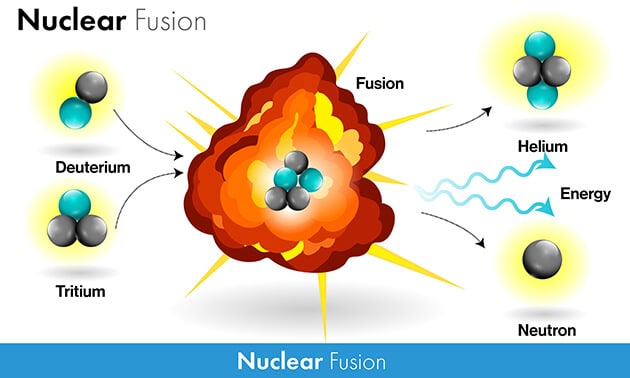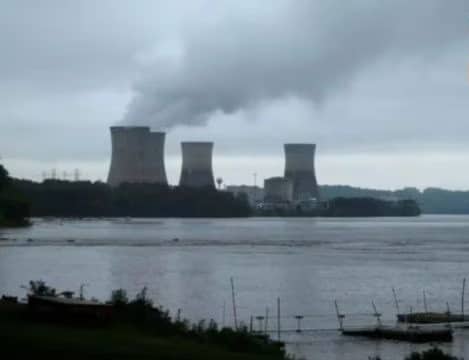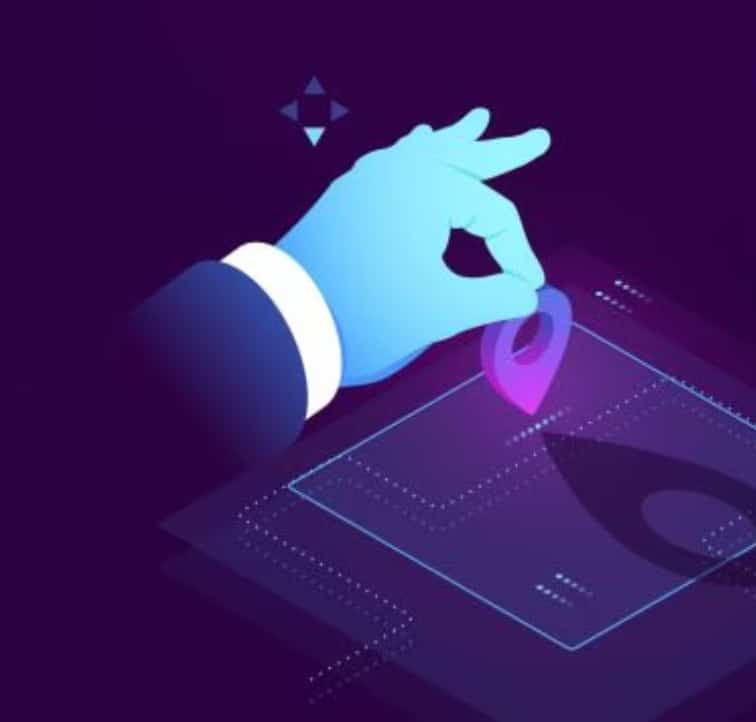What’s in today’s article?
- Why in News?
- About Nuclear Fusion Reaction (Meaning, Nuclear Fusion in Sun, Working of Nuclear Reactor)
- Difference between Fusion and Fission (Which is better, Why Fusion is difficult)
- News Summary
Why in News?
- Scientists in the United States have, for the first time, achieved a net gain in energy from a nuclear fusion reaction.
About Nuclear Fusion Reactions:
Image Caption: Nuclear Fusion Reaction
- Nuclear Fusion reactions power the Sun and other stars.
- In a fusion reaction, two light nuclei merge to form a single heavier nucleus.
- The process releases energy because the total mass of the resulting single nucleus is less than the mass of the two original nuclei. The leftover mass becomes energy.
- Albert Einstein’s equation, E=mc2, says in part that mass and energy can be converted into each other, explains why this process occurs.
- If scientists can harness nuclear fusion, it promises to provide a near-limitless source of clean energy.
- Sun is a giant nuclear fusion reactor. In Sun, the nuclear fusion process occurs mainly between hydrogen and helium, since that is the bulk of its composition.
What is the difference between Fission and Fusion?
- Fission:
- Fission occurs when a neutron slams into a larger atom, forcing it to excite and spilt into two smaller atoms—also known as fission products.
- When each atom splits, a tremendous amount of energy is released.
- Uranium and plutonium are most commonly used for fission reactions in nuclear power reactors because they are easy to initiate and control.
- The energy released by fission in these reactors heats water into steam. The steam is used to spin a turbine to produce carbon-free electricity.
- Fusion:
- Fusion occurs when two atoms slam together to form a heavier atom, like when two hydrogen atoms fuse to form one helium atom.
- This is the same process that powers the Sun and creates huge amounts of energy—several times greater than fission.
- Fusion reactions are being studied by scientists, but are difficult to sustain for long periods of time because of the tremendous amount of pressure and temperature needed to join the nuclei together.
How is Fusion better than Fission?
- Both fission and fusion use the binding energy of protons and neutrons in the nuclei of atoms to release an enormous amount of energy.
- The biggest problem with fission is that some of its by-products remain radioactive for years, and have to be disposed of in special facilities.
- Also, reactor accidents can release radioactive material into the environment, as happened at Three Mile Island in 1979 and at Chernobyl in 1986.
- Nuclear fusion reactors require only universally abundant hydrogen, they could be set up anywhere – unlike fission reactors that require rare radioactive substances like uranium.
- Also, the amount of energy produced from fusion is very large— four times as much as nuclear fission reactions — and fusion reactions can be the basis of future fusion power reactors.
- Once fusion energy is commercialized, the world would be able to produce virtually carbon-free electricity without any radioactive by-products.
Why is Fusion Energy so challenging to achieve?
- The Sun’s massive gravitational force naturally induces fusion, However, without that force, a higher temperature is needed for the reaction to take place.
- On earth, we need temperatures exceeding 100 million degrees Celsius and intense pressure to make nuclear fusion work, and sufficient confinement to hold the plasma and maintain the fusion reaction long enough for a net power gain.
- While conditions that are very close to those required in a fusion reactor are now routinely achieved in experiments, improved confinement properties and stability of the plasma are needed.
News Summary:
Image Caption: Lawrence Livermore Lab Experiment
- Scientists in the United States have, for the first time, achieved a net gain in energy from a nuclear fusion reaction.
- In simple terms, this is the first time a fusion reaction has produced more energy than it consumes.
What is the significance of USA’s fusion energy breakthrough?
- Fission-based power plants have been around since the 1950s, and India has several of its own.
- But scientists have been working for years to develop a reactor based on nuclear fusion, which is touted as a clean, abundant and safe source of energy.
- Nuclear fusion reactor could eventually allow humanity to break its dependence on fossil fuels that are driving a global climate crisis.
- Net energy gain has been an elusive goal because fusion happens at such high temperatures and pressures that it is incredibly difficult to control.
- The success of researchers at the Lawrence Livermore National Laboratory in California, USA can be seen as a big step forward in the decades-old endeavour to master a technology that is considered the most dependable source of energy in future.
Q1) Why nuclear fusion is called thermonuclear reaction?
Nuclear fusion is also called thermonuclear reaction because it takes place at extremely high temperature and hence create enormous amount of energy.
Q2) What are some disadvantages of fusion?
A long-recognized drawback of fusion energy is neutron radiation damage to exposed materials, causing swelling, embrittlement and fatigue.
Last updated on December, 2025
→ Check out the latest UPSC Syllabus 2026 here.
→ Join Vajiram & Ravi’s Interview Guidance Programme for expert help to crack your final UPSC stage.
→ UPSC Mains Result 2025 is now out.
→ UPSC Notification 2026 is scheduled to be released on January 14, 2026.
→ UPSC Calendar 2026 is released on 15th May, 2025.
→ The UPSC Vacancy 2025 were released 1129, out of which 979 were for UPSC CSE and remaining 150 are for UPSC IFoS.
→ UPSC Prelims 2026 will be conducted on 24th May, 2026 & UPSC Mains 2026 will be conducted on 21st August 2026.
→ The UPSC Selection Process is of 3 stages-Prelims, Mains and Interview.
→ UPSC Result 2024 is released with latest UPSC Marksheet 2024. Check Now!
→ UPSC Prelims Result 2025 is out now for the CSE held on 25 May 2025.
→ UPSC Toppers List 2024 is released now. Shakti Dubey is UPSC AIR 1 2024 Topper.
→ UPSC Prelims Question Paper 2025 and Unofficial Prelims Answer Key 2025 are available now.
→ UPSC Mains Question Paper 2025 is out for Essay, GS 1, 2, 3 & GS 4.
→ UPSC Mains Indian Language Question Paper 2025 is now out.
→ UPSC Mains Optional Question Paper 2025 is now out.
→ Also check Best IAS Coaching in Delhi

















